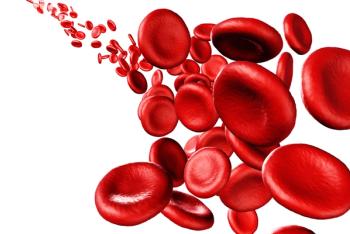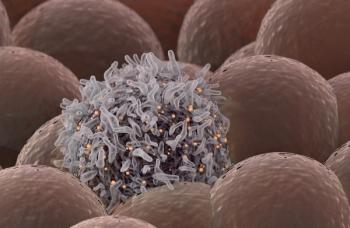
Later-Line Surufatinib Combo Shows Promising Activity in Metastatic PDAC
Updated phase 2 results support further investigation of surufatinib plus TAS-012 in a larger cohort of patients with pancreatic ductal adenocarcinoma.
Adding surufatinib (Sulanda) to TAS-102—a combination of trifluridine and tipiracil hydrochloride—produced promising survival outcomes and manageable toxicity as later-line therapy for a small cohort of patients with refractory metastatic pancreatic ductal adenocarcinoma (PDAC), according to data from a phase 2 trial (NCT05481463) presented in a poster session at the
Among 20 evaluable patients, study treatment yielded a median progression-free survival (PFS) of 2.35 months (95% CI, 1.91-3.94) and a median overall survival (OS) of 6.44 months (95% CI, 3.81-not reached [NR]). Among patients without liver metastases vs those with liver metastases, respectively, the median PFS was 3.42 months vs 2.01 months (P = .049), and the median OS was 9.92 months vs 3.70 months (P = .026).
For patients with 2 or fewer metastatic organs and those with more than 2 metastatic organs, respectively, the median PFS was 3.94 months vs 1.91 months (P = .005), and the median OS was 10.09 months vs 3.81 months (P = .003). The median OS was 9.92 months in patients with baseline CA19-9 levels of 996.7 u/ml or lower compared with 3.70 months in those with CA19-9 levels of more than 996.7 u/ml (P = .008).
Data showed an objective response rate (ORR) of 15.0%, which consisted of 3 partial responses (PRs). Additionally, the disease control rate (DCR) was 30.0%. Shrinking or stable tumors were reported in 35.0% of patients.
“Surufatinib plus TAS-102 showed encouraging survival benefits and promising anti-tumor activity with acceptable toxicity in late-line treatment of refractory [metastatic] PDAC, especially in patients without liver metastases, with [2 or fewer] metastatic organs, or with baseline CA19-9 level [of 996.7 u/ml or lower],” Dong-Sheng Zhang, PhD, of the Medical Oncology Department at Sun Yat-sen University Cancer Center, State Key Laboratory of Oncology in South China, and Collaborative Innovation Center for Cancer Medicine at Sun Yat-sen University, wrote with study coauthors.1 “The results warrant further investigations in a large cohort.”
In this single-arm, single-center study, 20 patients were assigned to receive surufatinib at 250 mg orally once daily plus TAS-102 at 35 mg/m2 on days 1 to 5 and days 8 to 12 twice daily every 4 weeks. Study treatment continued until disease progression, unacceptable toxicity, or death.
The trial’s primary end point was investigator-assessed PFS per RECIST v1.1 criteria.2 Secondary end points included DCR, OS, ORR, quality of life, and adverse effects (AEs).
Patients 18 to 75 years old with unresectable locally advanced or metastatic PDAC and an ECOG performance status of 0 or 1 were eligible for enrollment on the trial. Other requirements for study entry included having 1 or more measurable lesions per RECIST v1.1 guidelines and disease progression on at least 2 prior lines of therapy. Those with BRCA1/2-mutated disease were eligible for enrollment if they received prior platinum-based therapy.
The median age was 58 years (range, 41-72), and most patients were 60 years or younger (65.0%) and male (70.0%). All patients had an ECOG performance status of 1, stage IV disease, and adenocarcinoma histology. Additionally, most patients had primary tumor sites in the Cauda corporis pancreatis (40.0%), distant metastases in the lung (65.0%), KRAS-mutated disease (70.0%), and microsatellite stable disease (65.0%). The median CA19-9 level at baseline was 996.7 u/ml (range, 2-16612).
Across the safety population (n = 22), all patients experienced any-grade treatment-emergent AEs (TEAEs), which included anemia (59.1%), neutropenia (54.6%), leukopenia (50.0%), and lymphopenia (45.5%), among others. Grade 3 or higher TEAEs affected 50.0% of patients, with the most common types including neutropenia (31.8%), lymphopenia (13.6%), and anemia (9.1%).
References
- Zhang D-S, Lu Y-X,Liu F-R, et al. Surufatinib combined with TAS-102 as a late-line therapy in patients with metastatic pancreatic cancer (mPDAC): updated results of a single-arm, phase II trial. J Clin Oncol. 2025;43(suppl 4):739. doi:10.1200/JCO.2025.43.4_suppl.739
- Surufatinib combined with TAS-102 in third-line and later-line therapy of patients with advanced pancreatic cancer. ClinicalTrials.gov. Updated November 13, 2023. Accessed January 24, 2025. https://tinyurl.com/4dnkzrrv
Newsletter
Stay up to date on recent advances in the multidisciplinary approach to cancer.
































































































